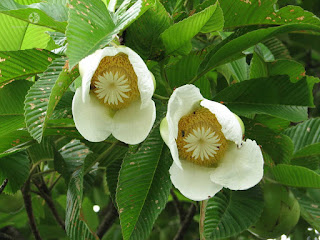Sanjeet Kumar
Dillenia indica L.
Common name: “Awoo”
Botanical name: Dillenia indica L.
Family: Dilleniaceae
Distribution
It is native to Southeastern Asia, Deccan peninsula, Sub-Himalayan tract, West Bengal, Assam, Meghalaya , Sri Lanka , Myanmar , China , Sumatra, Java , Bangladesh , Vietnam , Thailand , Malaysia , Indonesia
Moderate sized evergreen tree with a dense crown. Trunk rather crooked and irregular. Leaves deep green, oblong to lanceolate, pubescent beneath. Flowers white, solitary. Sepals, elliptic, thick. Carpels yellowish green with linear-lanceolate. Fruit indehiscent, yellowish-green. Seeds 5 or more in each carpel in colourless glutinous pulp, reniform, black.
Medicinal properties
Fruit juice is mixed with sugar is used as cooling beverage against fever. Fresh fruit juice is used as a cardio tonic. Leaves and bark are used as laxative. Different leaf extracts have anti-inflammatory activity.
Chemical Compound(s)
It has Lupeol group of triperpene, sucha as Betulinic acid, Flavonol such as myricetin. In stem bark there are many chemical compounds such as betulin, betulinaldehyde, betulic acid, flavonoids, dillentin, dihydroisorhamnetin, lupeol, glucosides, B-sitosterol; Wood: betulinic acid, lupeol, β-sitosterol; Leaf: cycloartenone, flavonoids, n-hentriacontanol, Bsitosterol; Fruit: an arabinogalactan, betulinic acid, β-sitosterol.
Common Use(s)
· Fruits are edible in Odisha and seed pulp is used to make jam and jellies.
· It is planted as ornamental plants due to beautiful flowers.
· Fruit decoction is used to cure dandruff in Manipur.
· Leaf paste is used to cure dysentery by Santhal in Odisha.






No comments:
Post a Comment